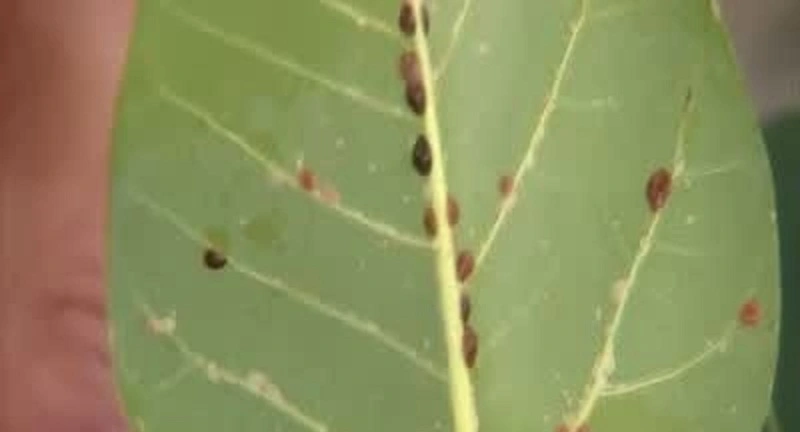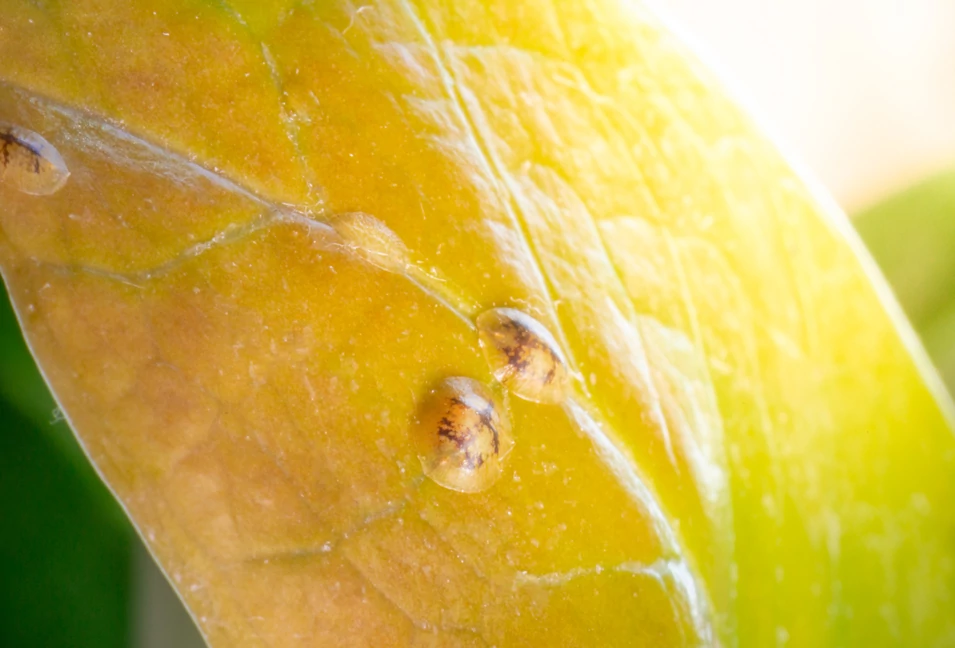Diaspididae are fast-breeding insects. They suck the sap from plants and release a sweet sticky substance – pad, which attracts ants.
Diaspididae most often infects orchids with hard leaves (Phalaenopsis, Cattleya and Cymbidium), citrus, ficus and others.
From the influence of Diaspididae the plant begins to weaken: the leaves wither, turn yellow and fall off, also changes the color of the leaves and the shape of flowers.
Females are aphids, which produce a specific wax that forms a protective shield. The shield itself can be round or elongated, from light to dark brown. The size of the shield can be from 0.5 mm to 5 mm. Under the shield Diaspididae lays eggs (up to 3000 pieces), from which hatch very small, mobile young individuals. Females are immobile, as they are firmly attached by a proboscis to the plant. After the death of the mother, the shield rises and the young individuals scatter on the plant. Unlike females, males can easily move from plant to plant.
Signs
Depending on the structure of the shield, pests can be divided into two groups:
- Diaspididae – a convex shield that is part of the insect and attached to it.
- False Diaspididae – shield flat, it can be gently picked up with a needle and lifted.
Diaspididae and Diaspididae are fast-breeding insects that suck sap from plants.
Reproduction can be asexual or sexual; some species are viviparous, others lay eggs. After hatching from an egg, the young individual goes through several stages of development. At the initial stage, they are very small (invisible to the naked eye), mobile and can spread quickly from plant to plant, then lose the ability to move and become overgrown with shield.
Males have two front wings and can fly to other plants, their size is small – from 1 to 2 mm; the life cycle is very short – only a few days. Unlike males, females live several months.
Pests do not infect healthy, well-developed plants that produce insect repellents. Weakened and excessively nitrogenous plants are infected, in which metabolism was disturbed by improper care (light, improper watering, too hot or too cold air, etc.). Especially dangerous in the winter, at this time, due to short daylight and dry air, plant sap undergoes certain changes that create ideal conditions for rapid reproduction of pests.
Prevention of Diaspididae
As a preventive action you can use:
- NIM OIL (Azadirachta indica, Schädlingsfrei Neem), which is obtained from the fruits of this tree, it can save you from the thyroid glands, when the plant is very small – 2-3 maximum 5, with severe damage, it is unfortunately not a helper.
- Natural enemies of Diaspididae – good lighting and high humidity.
Diaspididae
It is not recommended to collect Diaspididae by hand, you can remove the shields, inside which sit young individuals are ready for independent living; by damaging the shield, you only contribute to the faster spread of Diaspididae.

Treatment of Diaspididae
- Folk methods:
Garlic: Garlic juice is rubbed into the affected areas. Alternatively, garlic can be crushed to a homogeneous mass and applied with a brush to the leaves. - Olive oil: 1 liter of water is mixed with 2 tablespoons of olive oil, and then apply the resulting emulsion on the leaves.
It is best to use a brush in hard-to-reach places. Treatment is carried out in three stages with an interval of 7-10 days.
- Ethyl alcohol: cotton wool is moistened with alcohol and the damaged areas are rubbed. Alcohol dries shields (not for orchids).
- Chemicals: insecticides.
They are of three different types:
Contact – ie penetrate the skin of insects (pyrethrins, pyrethroids, etc.). The most common insecticides of this group are Spruzit-AF Schädlingsfrei, Promanal AF Neu (made in Germany) and Permethrin. The drug is very effective in small populations of insects, as a rule; re-treatment of the plant is not required.
Intestinal – insects enter the body through the mouth (Eylau). This group includes Aktellik, Arrivo, Aktara (intestinal-contact action).
Systemic – are absorbed by the roots and leaves of plants, get into the juice and make it toxic to parasites (methylmercaptophos, phosphamide, etc.). This group includes almost all sprays for pest control, such as Lizetan-Plus-Zierpflanzenspray and Bi 58 and others.
When using the spray, read the instructions carefully.
Under no circumstances should treated plants be left in direct sunlight.

